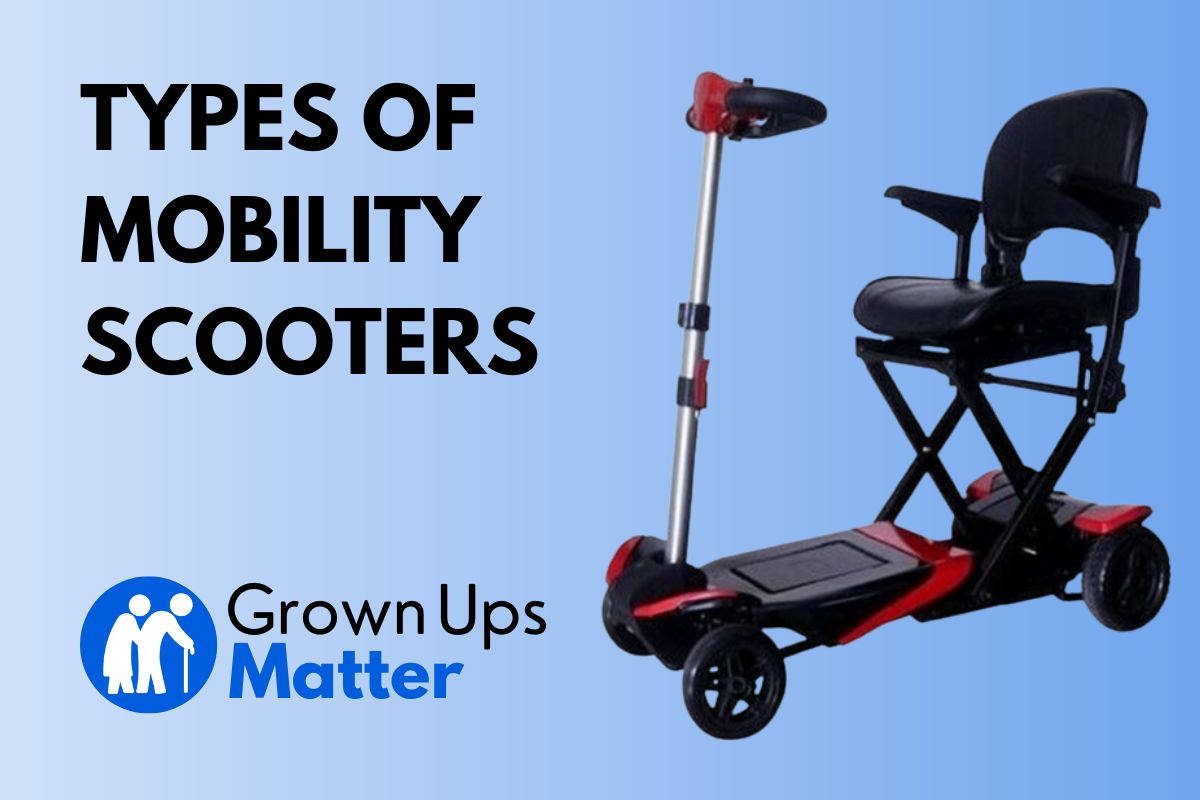Are you tired of struggling to walk long distances or feeling dependent on others for transportation?
A mobility scooter may be the solution you’re looking for.
These electric scooters, designed for those with mobility issues, offer a convenient and comfortable way to get around.
But with so many different types available, it can be overwhelming to choose the right one.
That’s where we come in.
In this article, we’ll introduce you to 10 different types of mobility scooters and help you pick the one that’s best for you.
From compact, portable models to heavy-duty scooters with advanced features, we’ll cover all the options and give you the information you need to make an informed decision.
So, if you’re ready to regain your independence and mobility, keep reading to learn about the top 10 mobility scooters on the market.
Key Takeaways:
- Standard scooters are base models covered by insurance companies and have no special features
- Standard scooters are great as a permanent mobility aid, for home use, indoor, and outdoor use in pedestrian paths
- Folding scooters have a middle hinge that makes them easily transportable in a car or other vehicle
- Travel scooters are lightweight and in many cases foldable, many models have airline-friendly batteries
- Three-wheel scooters are great for home use due to their tighter turn radius
- Four-wheel scooters are more stable and slightly better on rough terrain, but they are heavier and slightly more expensive
- Heavy-duty scooters are preferred for obese users, have better suspension, longer ranges, and are more durable
- All-terrain scooters are great for offroad adventures since they have rugged wheels and enhanced suspension
- Standing scooters are cheaper, lighter, and only recommended for patients that have no issue standing up for long periods of time
- Tandem scooters have 2 or more seats and are great for couples, friends o people that have to move with a caretaker
- Road scooters, as their name implies are designed to be used in regular roads
1. Standard Scooters
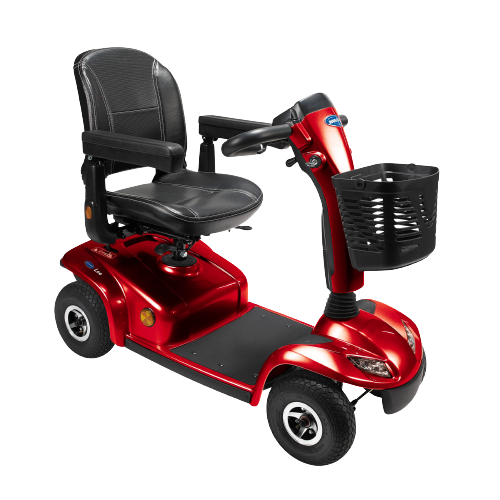
The category of “standard scooters” is an umbrella term we commonly use to describe base models, mostly intended for home use or light outdoor operation.
They can either have 3 or 4 wheels and are what you will expect Medicare or any other private insurance company may cover in case you qualify for one.
Best for:
- Regular all-day use
- Permanent mobility aid
- Home use
- Pedestrian outdoor paths
- Traveling small distances
2. Folding Scooters
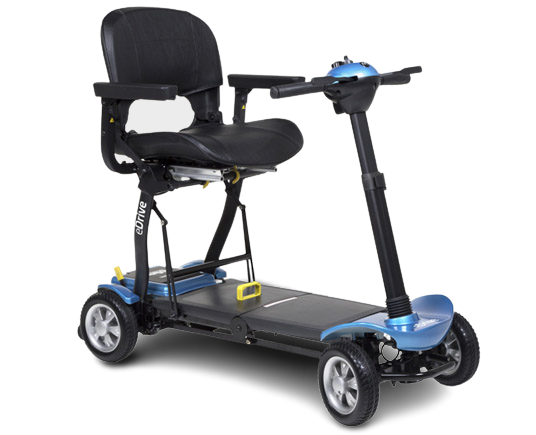
Folding scooters are usually lighter and intended to be portable and easily deployable.
Their main feature, as you might expect is that they usually have a hinge in the middle of their footboard that lets the device be folded.
In many cases, the folding process is automated and requires only the push of a button.
Although most mobility scooters disassemble in many parts to facilitate transporting them, foldable ones are just more practical, since there’s no putting them back together once you reach your destination.
You just unfold them and go.
Best for:
- Specific use
- Temporary mobility aid
- Pedestrian outdoor paths
- Home use
3. Travel scooters

These are lightweight and portable scooters that can be easily disassembled for transport in a car trunk or other small spaces.
These are ideal for plane travel since many models also come with certified non-spillable batteries that are safe for this medium of transport, and what airlines prefer.
A big downside for these lighter frames is that they might lack some rigidity and stability.
They are also not rated for carrying that much weight, and usually recommended for users under 300 lbs.
Best for:
- Vacation use
- Temporary mobility aid
- Pedestrian outdoor paths
- Home use
4. Three-wheel scooters
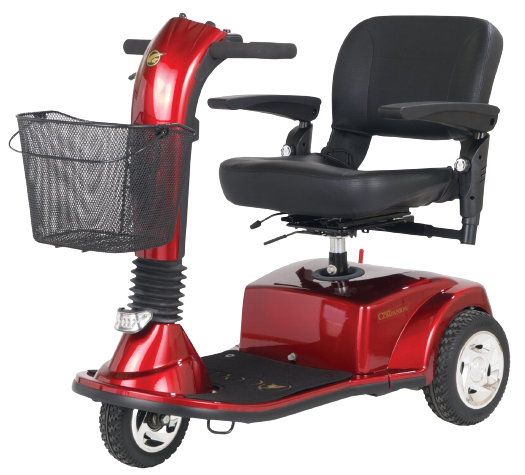
These scooters have a triangular shape and are typically more maneuverable than four-wheel scooters, making them a good choice for indoor use.
Particularly, having a single front wheel allows for these mobility aids to turn around with a sharper radius, which makes them ideal for small hallways or compact rooms.
A common worry many people have with this alternative is that they perceive them as being unstable.
This is not completely true.
All kinds of mobility scooters are designed to be safe to drive up to a standard that rarely will be matched in habitual daily use.
It’s true, though, that 4-wheel alternatives are slightly more stable, but that comes with certain drawbacks.
We have an article on the main differences between these 2 kinds of scooters that you might find very informative:
Best for:
- Regular all-day use
- Home use
- Temporary mobility aid
- Permanent mobility aid
- Pedestrian outdoor paths
- Traveling small distances
5. Four-wheel scooters
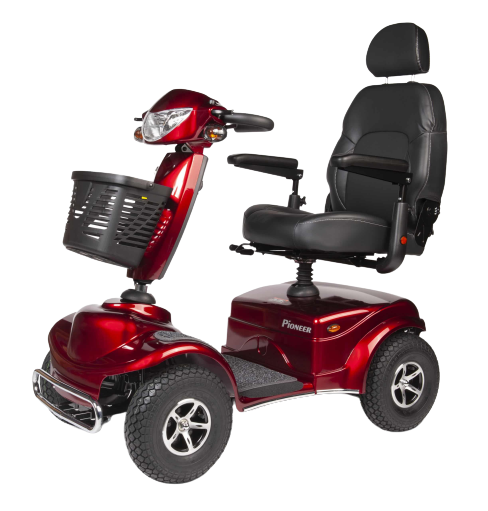
These scooters have a more stable design and are better suited for outdoor use on rough terrain, to a degree.
Standard 4-wheel scooters are not rated for off-road capabilities, and although you might benefit from the increased turning traction, it’s not a great idea to drive them over gravel or other harsh surfaces.
The extra stability and traction come at the price of increased weight and price.
Again, please refer to the article linked above for more differences between the most common alternatives for scooters.
Best for:
- Individuals that require to lean over the device to get in or out
- Outdoor use
- Home use if enough turning space available
- Temporary mobility aid
- Permanent mobility aid
- Pedestrian outdoor paths
- Traveling small distances
6. Heavy-duty scooters
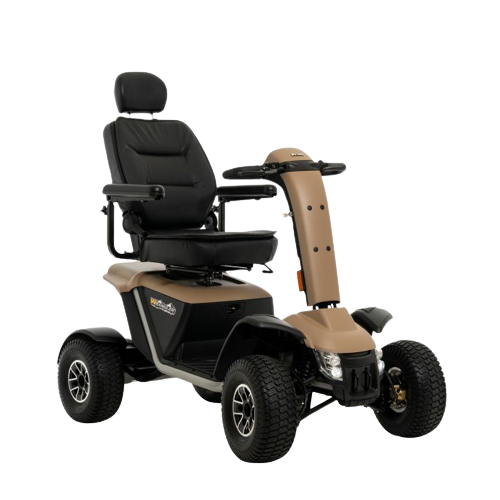
These scooters are designed for larger, heavier individuals and are capable of supporting higher-weight capacities.
Mostly used for patients going through bariatric treatment, these devices are usually tougher, have better suspension, and are more durable in general.
Usually equipped with longer-range batteries, and with the capability to accommodate passengers of up to 600 lbs, these powered mobility devices are no joke.
All these perks, however, come with the expected drawback of them not being the best option for home or even indoor usage.
There’s also a certain overlap in models between heavy-duty options and all-terrain ones.
Best for:
- Bariatric patients (obesity treatment)
- Permanent mobility aid
- Pedestrian outdoor paths
- Light off-road use
7. All-terrain scooters
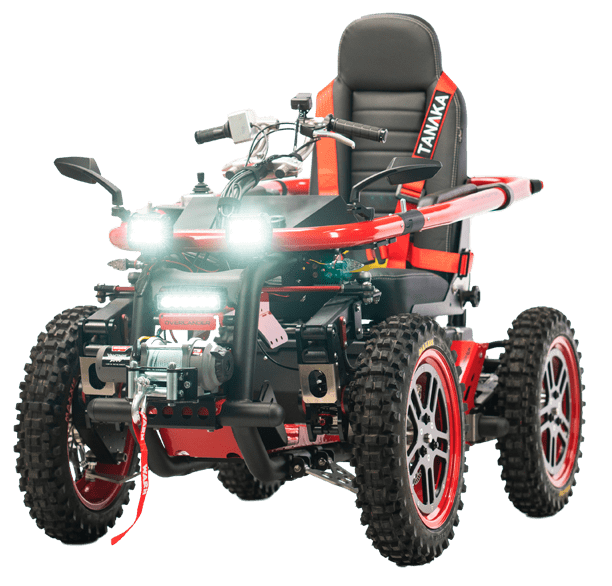
These scooters have larger, more rugged wheels paired with specialized suspension and are designed for use on a variety of terrain, including grass, gravel, and uneven surfaces.
More akin to a quad bike, this is the alternative for the most adventurous users, and for those who live in areas where roads are not well-maintained.
If there are roads at all.
Again, all this ruggedness comes at a way higher price point than regular scooters, and these are also not deemed appropriate for home or indoor use.
Best for:
- Outdoor use
- Heavy off-road use
- Temporary mobility aid
8. Standing scooters

These scooters allow the rider to stand while operating the scooter.
They have a smaller footprint, are lighter, and are cheaper.
However, these are perhaps not that common for dealing with mobility limitations because of obvious reasons.
In any way, if the patient has no problem standing up for longer periods of time, and their issue is only with walking, these can be a great alternative.
Best for:
- Temporary mobility aid
- Pedestrian outdoor paths
- People that have no problem standing up for long periods of time
9. Tandem Scooters
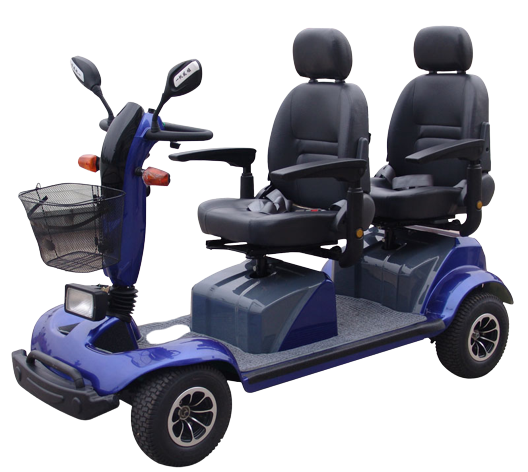
We have an article where we analyze Tandem scooters in great detail.
You can check it out here:
The short version is that tandem scooters are those that accommodate at least 2 passengers.
These are intended for couples, friends, people that need to be accompanied by their caretakers, or even for those who enjoy being driven around.
Best for:
- Couples, friends, caretakers
- Pedestrian outdoor paths
- Temporary mobility aid
- Traveling small distances
10. Road Scooters

Road scooters are mobility aid devices that are designed and intended to be driven on public roads.
The example we picked is a tricycle version, but you might also find them in 4-wheel configurations.
These vehicles have extended ranges, can be driven faster, and are meant to be road legal in most places.
Best for:
- Road use
- Temporary mobility aid
All the claims made in this article are only for informational purposes, based on the writer’s experience and not clinical advice. You should always consult your physician or physical therapist if you have any doubts about how this applies to your specific case.

Mallory is an occupational therapist with a passion for helping the elderly maintain their independence and mobility. After working in the field for several years, she decided to start sharing her knowledge and experience with a wider audience. Through this site, Mallory offers practical tips and exercises to help seniors improve their mobility and manage any limitations they may have. She is dedicated to providing accessible and effective resources to help her readers lead happy and healthy lives.

